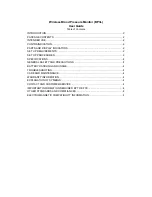
1.5 Daktronics Nomenclature
To fully understand some Daktronics drawings, such as schematics, it is necessary to
know how various components are labeled in those drawings. This information is
also useful when trying to communicate maintenance or troubleshooting efforts.
Figure 5: Module Numbering for Reference
A module is the building block of the Galaxy
®
display. The 12 mm modules measure
24 pixels high by 16 pixels wide and the 20 mm modules measure 16 pixels high by
16 pixels wide. By placing modules side-by-side and on top of one another, a display
of any size can be designed and built. Individual modules can be easily removed
from the display if required.
shows how Daktronics numbers modules on a
Galaxy
®
illustrates the module numbering method.
In addition, the following labeling formats might be
found on various Daktronics drawings:
Figure 6: Module Numbering
Technique
•
“TB_ _” signifies a termination block for
power or signal cable
•
“F_ _” represents a fuse
•
“E_ _” shows a grounding point
•
“J_ _” denotes a power or signal jack
•
“P_ _” stands for a power or signal plug
for the opposite jack
Finally, Daktronics part numbers are commonly
found on drawings. Those part numbers can be used when requesting replacement
parts from Daktronics Customer Service. Take note of the following part number
formats:
•
“0P-_ _ _ _-_ _ _ _” indicates an individual
circuit board, such as the internal fiberboard
Figure 7: Typical Label
•
“0A-_ _ _ _-_ _ _ _” stands for an assembly,
such as a circuit board and the plate or bracket
to which it is mounted
•
“W-_ _ _ _” represents a wire or cable
Note:
A collection of circuit boards working as a single unit may carry an assembly
label. Cables may also carry the assembly numbering format in certain
circumstances. This is especially true of ribbon cables.
1-6
Introduction













































